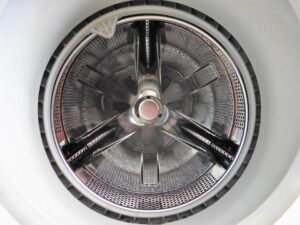Washer vibration is a common issue that many homeowners face. It occurs when the washer machine shakes or moves excessively during the spin cycle. While some level of vibration is normal, excessive vibration can be a cause for concern. Not only can it be annoying and disruptive, but it can also lead to damage to your home and potential safety hazards. That’s why it’s important to address washer vibration issues as soon as they arise.
Having a stable and quiet washer is essential for a comfortable and efficient laundry experience. A stable washer ensures that your machine operates smoothly and efficiently, reducing wear and tear on the internal components. It also helps to prevent excessive noise and vibrations that can disrupt your daily activities. Additionally, a stable washer reduces the risk of damage to your flooring and walls, saving you from costly repairs in the long run.
Key Takeaways
- Washer vibration can cause damage to your home and appliances
- Common causes of washer vibration include unbalanced loads and worn parts
- Identifying vibrations in your washer can help prevent further damage
- Proper installation and maintenance can prevent washer vibration issues
- If vibration issues persist, it may be necessary to call a professional for repairs
Common Causes of Washer Vibration
There are several common causes of washer vibration that homeowners should be aware of. One of the most common causes is unbalanced loads. When the laundry inside the machine is not distributed evenly, it can cause the washer to become off-balance during the spin cycle, resulting in excessive vibrations. Another common cause is worn out or damaged parts, such as shock absorbers or suspension springs. These parts are designed to absorb vibrations and keep the machine stable, but over time they can wear out or become damaged, leading to increased vibration.
Improper installation can also contribute to washer vibration issues. If the machine is not level or if it is not properly secured to the floor, it can cause the machine to vibrate excessively during operation. Uneven flooring can also be a contributing factor. If the floor underneath the washer is not level, it can cause the machine to wobble and vibrate.
Identifying Vibrations in Your Washer
It’s important to be able to identify signs of washer vibration so that you can address the issue promptly. Some common signs of washer vibration include excessive noise during operation, shaking or moving of the machine, and visible movement of the drum inside the machine. If you notice any of these signs, it’s important to take action to determine the severity of the vibration.
To determine the severity of the vibration, you can perform a simple test. Start by running an empty load in your washer. If the machine vibrates excessively even without any laundry inside, it indicates a more serious issue that needs to be addressed. On the other hand, if the machine only vibrates when it is loaded with laundry, it may be a sign of an unbalanced load or improper loading technique.
The Effects of Washer Vibration on Your Home
Washer vibration can have several negative effects on your home. One of the most common effects is damage to your flooring and walls. Excessive vibrations can cause tiles to crack or loosen, and can even cause wooden floors to warp or become damaged. Additionally, vibrations can cause plaster or drywall to crack or become damaged, leading to costly repairs.
Another effect of washer vibration is noise pollution. Excessive noise from a vibrating washer can be disruptive and annoying, especially if your laundry room is located near living areas or bedrooms. This can interfere with your daily activities and disturb your sleep.
In addition to damage and noise pollution, washer vibration can also pose potential safety hazards. A vibrating washer can become unstable and move around during operation, increasing the risk of accidents or injuries. It’s important to address washer vibration issues promptly to ensure the safety of yourself and your family.
Steps to Prevent Washer Vibration
Preventing washer vibration starts with proper loading techniques. It’s important to evenly distribute the laundry inside the machine to prevent unbalanced loads. Avoid overloading the machine and make sure that the weight of the laundry is evenly distributed around the drum.
Regular maintenance is also key to preventing washer vibration. This includes cleaning the machine regularly to remove any debris or buildup that can affect its performance. It’s also important to inspect the machine for any signs of wear or damage, and to replace any worn out parts promptly.
Choosing the right washer for your home is another important step in preventing vibration issues. Consider the size and capacity of the machine, as well as its features and specifications. Look for a washer that is designed to minimize vibrations and noise during operation.
How to Stabilize Your Washer

If you’re experiencing washer vibration issues, there are several steps you can take to stabilize your machine. One option is to use anti-vibration pads. These pads are placed underneath the washer and help to absorb vibrations, reducing noise and movement. They are easy to install and can make a significant difference in stabilizing your machine.
Another option is to adjust the leveling feet on your washer. These feet can be adjusted to ensure that the machine is level and stable on the floor. Use a level tool to check the machine’s levelness and adjust the feet as needed.
If you have a particularly unstable floor, you may need to reinforce it to prevent washer vibration. This can be done by adding additional support underneath the floor, such as plywood or additional joists. Consult with a professional if you’re unsure about how to reinforce your flooring.
Importance of Proper Installation
Proper installation plays a crucial role in preventing washer vibration issues. When installing your washer, make sure that it is level and properly secured to the floor. Follow the manufacturer’s instructions carefully and use any provided installation hardware.
Avoid common installation mistakes, such as placing the washer on an uneven surface or failing to secure it properly. These mistakes can lead to excessive vibrations and potential damage to your machine.
Maintenance Tips to Avoid Vibration Issues
Regular maintenance is essential for preventing washer vibration issues. Start by cleaning your machine regularly to remove any debris or buildup that can affect its performance. This includes cleaning the drum, detergent dispenser, and any filters or hoses.
Inspect your machine regularly for any signs of wear or damage. Check the suspension springs, shock absorbers, and other moving parts for any signs of wear or damage. If you notice any issues, replace the worn out parts promptly to prevent further damage and vibration.
Lubricating moving parts is another important maintenance task. Over time, moving parts can become dry and stiff, leading to increased friction and vibration. Use a lubricant recommended by the manufacturer to keep these parts running smoothly.
When to Call a Professional
While many washer vibration issues can be addressed with DIY solutions, there are times when it’s best to call a professional. If you’re unsure about how to address the issue or if you’re experiencing severe vibrations even after trying various solutions, it’s best to seek professional help.
Signs that you need professional help include excessive noise or movement of the machine, visible damage to the machine or surrounding area, or if you’re unable to determine the cause of the vibration. A professional technician will be able to diagnose the issue and provide the necessary repairs or adjustments.
Enjoying a Quiet and Stable Washer
In conclusion, addressing washer vibration issues is important for a comfortable and efficient laundry experience. Excessive vibrations can lead to damage to your home, noise pollution, and potential safety hazards. By following proper loading techniques, performing regular maintenance, and choosing the right washer for your home, you can prevent vibration issues from occurring.
If you do experience washer vibration issues, there are several steps you can take to stabilize your machine. Using anti-vibration pads, adjusting the leveling feet, and reinforcing the flooring are all effective solutions. Proper installation is also crucial in preventing washer vibration issues.
Regular maintenance is key in avoiding vibration issues. Cleaning the machine regularly, inspecting for wear or damage, and lubricating moving parts are all important maintenance tasks. If you’re unable to address the issue on your own or if you’re experiencing severe vibrations, it’s best to call a professional for assistance.
By taking action to prevent and address washer vibration issues, you can enjoy a quiet and stable washer that will last for years to come. Don’t let washer vibration disrupt your daily life – take the necessary steps to ensure a smooth and efficient laundry experience.
If you’re dealing with vibration issues in your washer, you’ll definitely want to check out this informative article on 911 Appliance’s blog. They provide valuable insights and tips on how to identify and stabilize your washer to prevent any further damage. With their expertise in appliance repair, you can trust their advice to help you resolve this common issue. Don’t let a vibrating washer disrupt your laundry routine any longer – click here to read the article and get your washer back on track.
How Can Vibration Issues Affect the Washer’s Electrical and Panel Problems?
Vibration issues with a washer can lead to serious electrical and panel problems, resulting in washer not starting issues. Excessive shaking can dislodge electrical connections and damage the control panel, leading to malfunctions. It’s important to address vibration issues promptly to prevent further damage to the washer.



